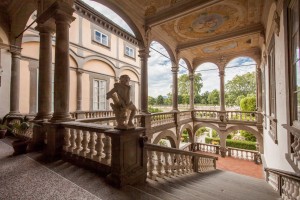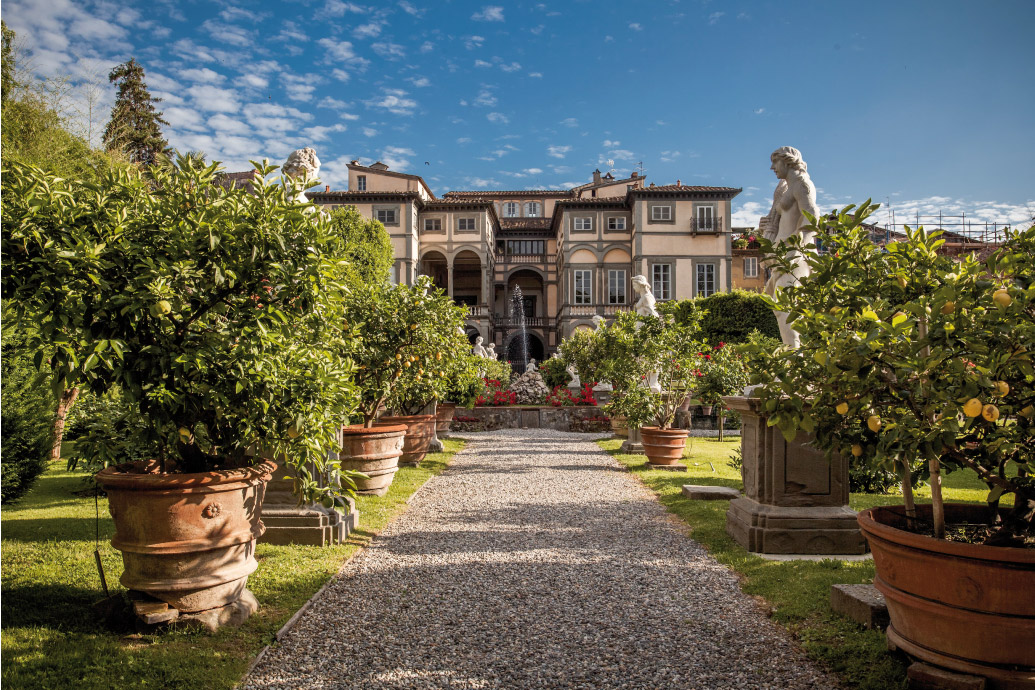 Palazzo Pfanner stands immersed in a baroque setting, just a few minutes away from the sixteenth-century town walls and the austere mediaeval palazzi of Lucca.
Palazzo Pfanner stands immersed in a baroque setting, just a few minutes away from the sixteenth-century town walls and the austere mediaeval palazzi of Lucca.
The Moriconi family, silk merchants and members of the nobility of the town of Lucca, began to build the Palazzo in 1660. Following a sudden financial crisis, the Moriconi family was forced to sell the building in 1680.
The Palazzo was taken over by the Controni family who, having acquired a noble title just a few years before, wished to celebrate their social accomplishments by renovating and enlarging the building.
The Controni most probably entrusted the work to the architect Domenico Martinelli (1650-1718) from Lucca to build the monumental main staircase (completed around 1686) and to the architect Filippo Juvarra (1678-1736) from Messina for the designing of the garden.
The grand staircase in sand stone, embellished with vaults decorated with early eighteenth-century paintings attributed to Bartolomeo De Santi (1687-1764) and to Lorenzo Castellotti (fl. 1730-1750), leads into the large main hall of the Palazzo.
Here on the walls visitors can admire the valuable frescoes painted in around the year 1720 by Pietro Paolo Scorsini (1658-1731), carried out according to the teachings of the quadraturist school. Quadraturism, which was very much in fashion in Lucca from the last decade of the seventeenth century onwards, was characterized by the desire to propose an illusory expanding of space by means of architectonic elements painted in perspective.
Next to the main hall there is a small drawing-room, a bedroom, a dining-room and an old kitchen, all of which are fitted with antique furniture, furnishings and sacred objects. It is precisely in these rooms that in 1692 the tormented love affair between Prince Frederick of Denmark, future King Frederick IV of Denmark and Norway, and the noblewoman Maria Maddalena Trenta from Lucca took its course.
Up to the second half of the nineteenth century the Palazzo remained property of the Controni family who in the face of economic difficulties decided to rent part of the rooms to the Monitorial System Schools and to the Court of Assizes.
The story of the Pfanner family becomes interwoven with the century-old history of the Palazzo towards the middle of the nineteenth century. In 1846 Felix Pfanner (1818-1892), a brewer from Hörbranz on the shores of Lake Constance in Austria, though his family was originally from Bavaria, came into contact with the Controni family. Following a decree of the year 1845 with which the Duke of Lucca Carlo Lodovico di Borbone had requested for himself and for the townspeople “a German brewer”, Felix decided to rent the garden and the cellars of the Palazzo from the Controni family in order to set up his machinery and the necessary equipment for brewing beer. As time passed, thanks to the proceeds of his brewery, Felix was able to buy the whole Palazzo which subsequently took his name and became the official headquarters of the Pfanner Brewery. The first beer manufacturer of the Duchy of Lucca and one of the first in Italy, the Pfanner Brewery became an important meeting-point for both people from the town and foreigners. After several decades of activity, the brewery closed down in 1929.
The Palazzo is still today property of the Pfanner family who lives here and who over the years has brought out the best of this building as a resource through opening it to the public and organizing events.
In the main hall of the Palazzo there is a permanent exhibition of medical and surgical instruments and antique medical texts which belonged to Pietro Pfanner (1864-1935) – surgeon, philanthropist and Mayor of Lucca from 1920-1922. Three films which have been shot here have undoubtedly contributed to the celebrity of Palazzo Pfanner; Arrivano i bersaglieri by Luigi Magni (1980), Il Marchese del Grillo by Mario Monicelli (1981) and Portrait of a Lady by Jane Campion (1996).





 The courtyard of Palazzo Pfanner seems to be tailor-made for hosting events, with its grand scenic flight of steps and entrance hall with arched ceilings,
The courtyard of Palazzo Pfanner seems to be tailor-made for hosting events, with its grand scenic flight of steps and entrance hall with arched ceilings,